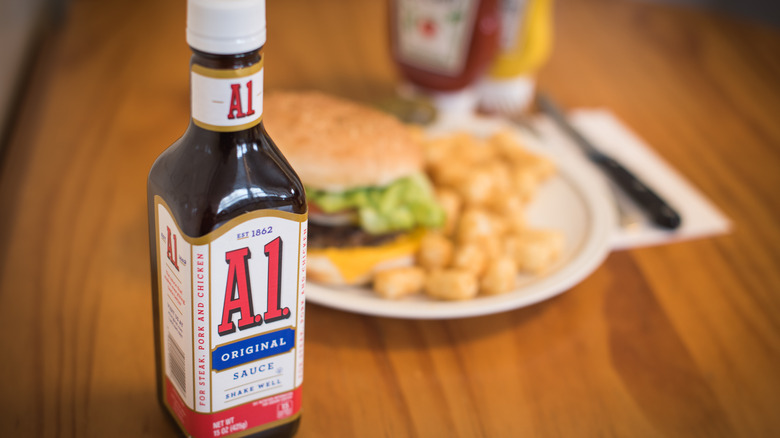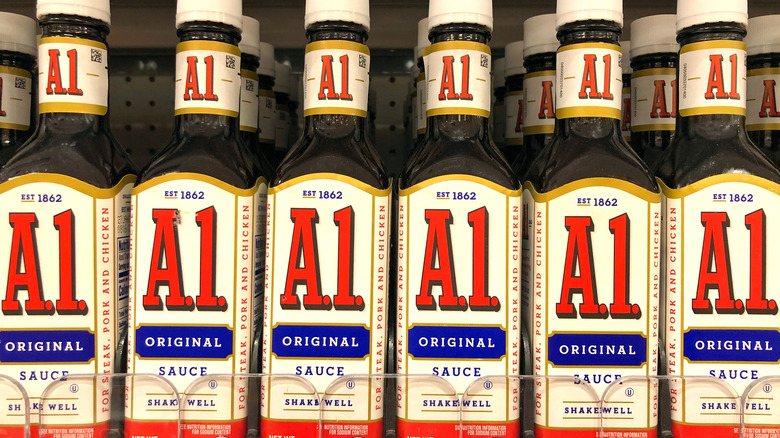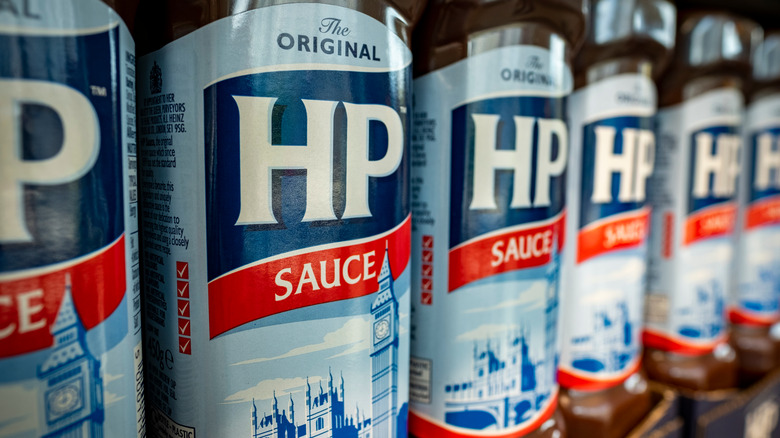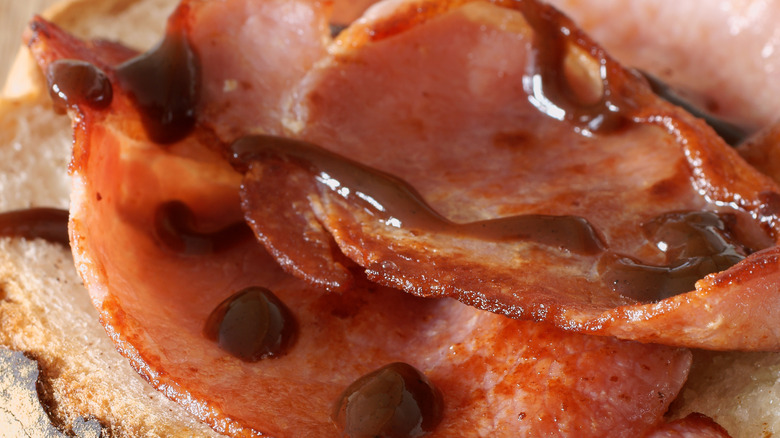Why You Won't Find A.1. Sauce In The UK
It doesn't matter if you like it rare, medium, or well done — if you've ever enjoyed a nice, thick steak, chances are high you've also enjoyed a drizzle of A.1. Sauce on top. The popular condiment is found on the tables of steakhouses across the United States and has been around since its invention all the way back in the 1800s (via How Stuff Works). Similar in taste and texture to Worcestershire sauce (minus the heat), the original flavor of A.1. Sauce is made up of ingredients like tomato purée, raisin paste, dried garlic, and onions, and it pairs well with everything from steak to burgers to chicken.
Despite how beloved — and how omnipresent — A.1. Steak Sauce is in the U.S., however, it's hard to come by across the pond. Why isn't the condiment sold in U.K. grocery stores? And why isn't it as abundant as it is here in America? The truth behind the lack of A.1. Sauce in the U.K. has less to do with the sauce itself and more to do with all of its competitors.
There are too many other steak sauces in the UK
Here in the U.S., when you think of steak sauce, you likely only think of A.1. But, that isn't the case in the United Kingdom, where there's a large variety of steak sauces to choose from, like Daddies as well as the multiple own brand sauces such as Tesco's Brown Sauce. One of the most popular is HP Sauce, and as The Guardian reports, it accounts for some 71% of the U.K.'s "brown sauce" market.
Surprisingly, however, A.1. Sauce was actually invented in Great Britain in 1862 by the co-manager of cuisine at Hyde Park's International Exhibition (via Let's Look Again). But in the 1970s, the tangy condiment was pushed out of the majority of U.K. supermarkets thanks to the plethora of other options — there simply was no more room for A.1. to compete in the British food space. But, if you find yourself on those sceptered isles and are craving a dash of America, you can still snag A.1. at Tesco online.
What's the difference between HP and A1 sauce?
Earlier you read that HP Sauce accounts for a majority of the "brown sauce" market in the United Kingdom. What exactly is HP Sauce and what makes it so different than the American-favored A.1.? If they're both a "brown sauce," wouldn't that mean it's the same stuff with a different label?
According to IHeartBritain, HP Sauce is similar to A.1. but only in a few minor aspects, such as what they're used for. While both sauces have a similar ingredients list, both having tomatoes, sugar, and vinegar, HP has the addition of tamarind while A.1. has "crushed orange puree." Tamarind is a tropical African plant that is reported to have applications in both sweet and savory dishes. MedMunch tells us that if tamarind is harvested early on it has a sour lemon-like taste, while tamarind that is harvested later — when it is more mature — has a much sweeter flavor. In a sense, tamarind replaces the orange citrus flavor that the American A.1. boasts.
IHeartBritain also explains that, while HP Sauce is a brown sauce, not all brown sauce is HP. It's in the same way that French's is a mustard, it reasons, but not all mustard is French's.
What is brown sauce anyway?
By now, you're probably wondering: What exactly is "brown sauce?" Is it just a fancy U.K. term for steak sauce or is it a whole different condiment outside of what we expect it to be? Maybe it's something we Americans can't understand — or at least that's what Cosmopolitan thinks.
Cosmopolitan describes brown sauce as being made of "tomatoes, molasses, spices, vinegar and sometimes dates [and] tastes a little sweet and a little tart." If anything, Cosmopolitan does admit that brown sauce isn't too dissimilar to what we call steak sauce. It could actually be considered a more modern take on ketchup, being sweeter and tarter than your usual bottle of Heinz.
You could even make your own brown sauce at home. Great British Chefs' recipe for brown sauce consists mainly of tomatoes, "treacle" (or molasses), aromatics such as onion, chili, cloves, ginger, and fennel seeds, apricots, and Worcestershire sauce. These ingredients are combined and simmered, adding the vinegar throughout until the mixture is reduced to a thick sauce-like consistency. From there, the sauce can be blended together and strained through a sieve before being served or stored. With this recipe, you can at least experiment and add or remove whatever ingredients you wish to get your preferred taste.
Who knows? Maybe you'll make your own A.1.!



